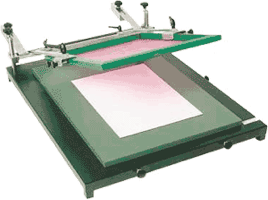ACQUAFORTE E SERIGRAFIA:
LA TECNICA
Etching and Silkscreen:
the technique

ACQUAFORTE E SERIGRAFIA:
LA TECNICA
Etching and Silkscreen:
the technique
L'acquaforte ha origine nel Medioevo quando l'acido nitrico (in latino acquarfortis) era usato per incidere decorazioni su armi e armature. Dalla fine del XV sec e l'inizio del XVI il nome e la tecnica sono state adottate da artisti incisorii. La lastra di zinco occorrente per incidere un'acquaforte viene perfettamente pulita. Dopo è coperta con uno strato di vernice resistente all'acido. L'immagine è successivamente tracciata con una punta acuminata che rimuove la vernice protettiva e scopre il metallo. La lastra viene ora immersa nell'acido. L'azione corrosiva dell'acido incide il metallo esposto dall'azione della punta. La durata di immersione nell'acido determina la profondità dell' incisione e la forza della stampa.
L'acquatinta è un processo simile all'acquaforte. Una larga parte della lastra viene esposta all'acido creando toni piuttosto che linee definite. Per fare un'acquatinta, alcune aree della lastra di metallo sono cosparse con polvere di zucchero, bitume, sale ecc che viene fissata con vari metodi. La lastra è in seguito immersa nell'acido che corrode le aree non protette. L'acquatinta è spesso impiegata come ausilio all'acquaforte e alla punta secca.
Entrambe, l'acquaforte e l'acquatinta, sono stampate con un torchio e raramente si producono più di 100-120 copie per lastra (ogni copia è numerata a margine).
The origins of etching go back to the Middle Ages when nitric acid (in latin acquafortis)
was used to engrave lines and decorations on arms and amour. By the end of the 15th century and the beginning of the 16th century the name and technique had been adopted by skilled engravers.
To make an etching , the zinc plate is thoroughly cleaned to remove all traces of grease. It is then covered in an even layer of varnish resistant to acid. The image is then engraved with a very fine steel point that removes the protective varnish on the plate. The plate is immersed in acid. The corrosive action of the acid dissolves the metal exposed by the point.The duration of immersion in the acid determines the depth of the etching and the strength of the impression.
Acquatint is a process similar to etching. A large part of the plate is exposed to the acid creating tones rather than definite lines.
To make an aquatint, some areas of the metal plate are sprinkled with dusts i.e. sugar,bitumen,salt etc. and held firm by various means. The plate is then immersed into an acid solvent which corrodes the unprotected areas. Acquatint is rather hard to control and is therefore often employed with acquaforte and dry point.
Both etching and acquatint are printed by a press which rarely produces more than 100-120 copies per plate (each copy is numbered in the margin).






di Maria Assunta Cannistraro
Via Porta all'Arco n.23
56048 VOLTERRA (PI), ITALY
email: laboistrice@gmail.com
cell:+393477269888
tel:+39058885422
LA SERIGRAFIA:
silkscreen
La tecnica
La serigrafia è una tecnica di stampa molto antica. Assai praticata in Cina è giunta in Europa solo agli inizi del 1900. In serigrafia la stampa avviene, come in litografia, per mezzo di un cliché e permette di stampare su qualsiasi superficie. Il cliché serigrafico consiste in un telaio sul quale viene teso un tessuto (seta, xeros in greco da cui serigrafia). Su questo tessuto viene poi applicato uno strato di gelatina fotosensibile. Il disegno o l’immagine da stampare vengono impressi esponendo il telaio così trattato alla luce. Con la luce la gelatina si fissa nelle zone esposte e viene invece dilavata in corrispondenza dei disegni o immagini da stampare, lasciando così scoperte le parti che accoglieranno l’ inchiostro. Per mezzo di una lamina di gomma si fa poi scorrere, premendo sul cliché, un inchiostro; questo passa solo attraverso le maglie del tessuto lasciate libere e, depositandosi sulla superficie del foglio o di un qualsiasi altro materiale, riproduce il disegno voluto.
Silkscreen is a very old print technique. Highly practiced in Cina it arrived in Europe only in the early ‘900. In silkscreen the printing process occurs, as in lithografy, through a cliché and it allows you to print on any surface. Silkscreen cliché is a frame on which a fabric is stretched (silk, xeros in greek). A layer of photosensitive gel is applied on the fabric; the image we want to print is impressed exposing the treated frame to light. Thanks to the action of the light the fotosensitive gel is fixed in the exposed areas and washed where we’ve the drawing, leaving uncovered the parts that will host the ink. Using a rubber foil we run the ink on the cliché; the ink passes through the free mashes and, depositing on the leaf surface or on any other material, it reproduce the desired drawing.




L’ACQUAFORTE
etching
La tecnica
